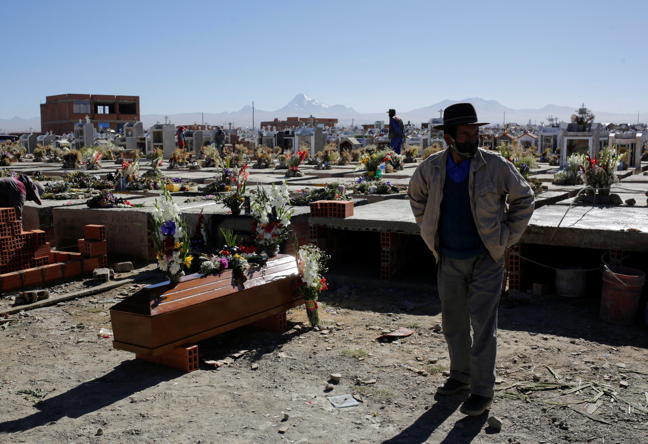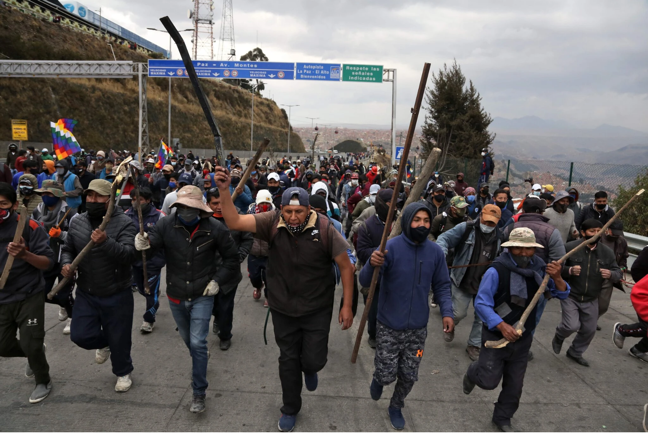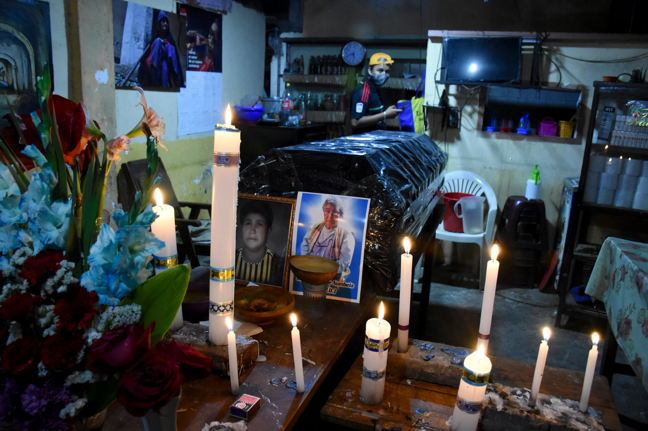
(above) A man standing near the coffin of a relative this month at a cemetery on the outskirts of La Paz.David Mercado/Reuters
As Politicians Clashed, Bolivia's Pandemic Death Rate Soared
August 22, 2020 - Original article: NY Times
Bolivia was mired in political turmoil when the pandemic hit. The response was chaotic. And the surge in deaths that followed was among the worst in the world, according to an analysis by The New York Times.
By María Silvia Trigo, Anatoly Kurmanaev and Allison McCann
TARIJA, Bolivia — So many people were dying that the government’s numbers couldn’t be accurate.
Calls to pick up bodies were inundating Bolivia’s forensic office. By July, agents were gathering up to 150 bodies per day, 15 times the normal amount in previous years, said the country’s chief forensic official, Andrés Flores.
The demand on his office suggested that the official tally of Covid-19 deaths — now just over 4,300 — was a vast undercount, Mr. Flores said. But with limited testing, scarce resources, and a political crisis tearing the country apart, the extra lives lost were going largely unrecognized.
New mortality figures reviewed by The Times suggest that the real death toll during the outbreak is nearly five times the official tally, indicating Bolivia has suffered one of the world’s worst epidemics. The extraordinary rise in death, adjusted for its population, is more than twice as high as that of the United States, and far higher than the levels in Italy, Spain and the United Kingdom.
About 20,000 more people have died since June than in past years, according to a Times analysis of registration data from Bolivia’s Civil Registry, a vast number in a country of only about 11 million people.
Tracking deaths from all causes gives a more accurate picture of the pandemic’s true toll, demographers say, because it does not depend on testing, which has been very limited in Bolivia. The mortality figures include people who may have died from Covid-19 and from other causes because they couldn’t get health care.
“This is a very cruel situation that we’re living through,” said Mr. Flores, who heads the Institute of Forensic Investigations. “We’ve been left completely exposed.”
With a bare-bones health system, a decentralized government and poor infrastructure, Bolivia struggled to contain infectious diseases such as dengue even before the coronavirus arrived, said Virgilio Prieto, an epidemiologist at Bolivia’s Health Ministry.
But its ability to respond was undermined by a contested election that led to the ouster in November of the then-president, Evo Morales, a socialist. An interim president, Jeanine Añez, a conservative, stepped in with a promise to govern until elections could be held.
Since then, Ms. Añez has announced that she is running for the office — and asked the electoral board to postpone the new vote, saying the pandemic made it unsafe for the population to go to the polls. The rescheduling of the vote from May to October has enraged opposition groups, who see it as an attempt by the caretaker president to cling to power.
(below) Jeanine Añez, the interim president, is running for president in elections now scheduled for October.Federico Rios for The New York Times

“She is not recognized as a legitimate leader, which makes it extremely difficult to coordinate a complex response that the pandemic requires,” said Santiago Anria, a Bolivia expert at the Dickinson College in Pennsylvania.
Ms. Añez’s decision to run for president herself antagonized the opposition lawmakers and regional officials on whom she depended to mobilize health care resources, said Mr. Anria, leading to a disorganized, ineffective effort.
Her response was also bogged down by corruption scandals, including the arrest of her health minister in May after investigators accused him of using money from international donors to buy hospital ventilators at twice the real cost.
Ms. Añez defended her approach to the outbreak, saying that her decision to enact a swift lockdown avoided an even greater loss of life. She also blamed Mr.
Morales’s party for mismanaging the health care system during its 14 years in office and stifling her plans to boost public spending in the pandemic.
Coronavirus Schools Briefing: The pandemic is upending education. Get the latest news and tips as students go back to school.
“We did more in three months than what was done in the history of health care of this country,” she wrote in a Twitter post this month.
More than a hundred road blocks by labor unions and Mr. Morales’s supporters have paralyzed an already weakened economy, leaving the government with fewer resources to import urgently needed medical supplies. The shortages of oxygen and other equipment caused by the road blocks resulted in the deaths of at least 30 patients, the government said in a report to the Organization of American States.
(below) Supporters of Evo Morales, the former president, blocked the highway between La Paz and El Alto this month to protest against a second postponement of the general election.Luis Gandarillas/Agence France-Presse — Getty Images

As hospitals ran out of medicines and coronavirus tests, Mr. Morales’s allies in congress passed a law to allow the medical use of a bleaching agent, chlorine dioxide — an unproven and potentially dangerous coronavirus treatment popular among Bolivians.
“The pandemic has found us in a very precarious situation, with an inexperienced government and elevated political tensions,” said Franklin Pareja, a political scientist at the San Andrés Major University in La Paz. “This political standoff has a cost in lives.”
In Bolivia’s political center, the La Paz region, five times as many people died in July than in past years, according to the data, a rate comparable with Madrid’s during its worst month. In the tropical plains region of Beni, more than seven times as many people died as normal, a number surpassing Bergamo, Italy, during its peak.
The Coronavirus Outbreak ›
Frequently Asked Questions
Updated August 17, 2020
Why does standing six feet away from others help?
The coronavirus spreads primarily through droplets from your mouth and nose, especially when you cough or sneeze. The C.D.C., one of the organizations using that measure, bases its recommendation of six feet on the idea that most large droplets that people expel when they cough or sneeze will fall to the ground within six feet. But six feet has never been a magic number that guarantees complete protection. Sneezes, for instance, can launch droplets a lot farther than six feet, according to a recent study. It's a rule of thumb: You should be safest standing six feet apart outside, especially when it's windy. But keep a mask on at all times, even when you think you’re far enough apart.
I have antibodies. Am I now immune?
As of right now, that seems likely, for at least several months. There have been frightening accounts of people suffering what seems to be a second bout of Covid-19. But experts say these patients may have a drawn-out course of infection, with the virus taking a slow toll weeks to months after initial exposure. People infected with the coronavirus typically produce immune molecules called antibodies, which are protective proteins made in response to an infection. These antibodies may last in the body only two to Gabriel Hetland: Bolivia is falling into the grips of a brutal right-wing regime
Álvaro Vargas Llosa: The Bolivian ‘coup’ that wasn’t
Gustavo Flores-Macías: Latin America’s generals, back in the political labyrinth
Francisco Toro: Bolivia needs a political solution out of this messy coup
three months, which may seem worrisome, but that’s perfectly normal after an acute infection subsides, said Dr. Michael Mina, an immunologist at Harvard University. It may be possible to get the coronavirus again, but it’s highly unlikely that it would be possible in a short window of time from initial infection or make people sicker the second time.
I’m a small-business owner. Can I get relief?
The stimulus bills enacted in March offer help for the millions of American small businesses. Those eligible for aid are businesses and nonprofit organizations with fewer than 500 workers, including sole proprietorships, independent contractors and freelancers. Some larger companies in some industries are also eligible. The help being offered, which is being managed by the Small Business Administration, includes the Paycheck Protection Program and the Economic Injury Disaster Loan program. But lots of folks have not yet seen payouts. Even those who have received help are confused: The rules are draconian, and some are stuck sitting on money they don’t know how to use. Many small-business owners are getting less than they expected or not hearing anything at all.
What are my rights if I am worried about going back to work?
Employers have to provide a safe workplace with policies that protect everyone equally. And if one of your co-workers tests positive for the coronavirus, the C.D.C. has said that employers should tell their employees -- without giving you the sick employee’s name -- that they may have been exposed to the virus.
What is school going to look like in September?
It is unlikely that many schools will return to a normal schedule this fall, requiring the grind of online learning, makeshift child care and stunted workdays to continue. California’s two largest public school districts — Los Angeles and San Diego — said on July 13, that instruction will be remote-only in the fall, citing concerns that surging coronavirus infections in their areas pose too dire a risk for students and teachers. Together, the two districts enroll some 825,000 students. They are the largest in the country so far to abandon plans for even a partial physical return to classrooms when they reopen in August. For other districts, the solution won’t be an all-or-nothing approach. Many systems, including the nation’s largest, New York City, are devising hybrid plans that involve spending some days in classrooms and other days online.There’s no national policy on this yet, so check with your municipal school system regularly to see what is happening in your community.
Although Bolivia’s official statistics show a severe spike in mortality starting in July, the closure of government offices during a lockdown in April meant that almost no deaths were registered that month. Officials at Bolivia’s Civil Registry, which issues death certificates, warned that at least some of the deaths that occurred in April could have been registered in later months, potentially skewing the mortality rate.
(below) The plastic-wrapped coffin of Rosa Rocha, 74, inside her family’s home after she died in July of Covid-19-like symptoms in Cochabamba, Bolivia.Dico Solis/Associated Press

The scale of the mortality spike, however, is confirmed by Bolivia’s overwhelmed crematories, cemeteries and body-collection agencies.
The spike in deaths had collapsed Bolivian hospitals and forced local authorities to expand their crematories and open new cemeteries. In La Paz’s municipal cemetery, residents and hearses had to line up outside the entry last week for a chance to bury their loved ones.
In Bolivia’s capital, Sucre, local health authorities said they had to stack up dozens of bodies in morgues, hospitals and even the local university, until they were able to install a new crematory oven to meet the demand. And in the central city of Cochabamba, families had to keep bodies of their loved ones at home for days because local funeral parlors and crematories could not handle the increase.
“The health system is saturated,” said the Health Ministry’s chief epidemiologist, Mr. Prieto. “We don’t have enough capacity, equipment or the intensive care units required.”
Despite the crisis, some regional governments, under pressure to restart the economy before the elections, are reopening gyms and restaurants, feeding fears that mortality rates will continue to rise. The Health Ministry estimates that the country will only reach the peak of the pandemic in September.
(below) A hospital bed outside a hospital morgue this month in La Paz.David Mercado/Reuters

And in the meantime, the population will continue to bear the burden of Bolivia’s ineffective response.
When Josué Jallaza, a 24-year-old taxi driver in Cochabamba, fell sick with coronavirus symptoms, his family called three times for a doctor, but no one ever came. After he fainted, his family took him to a hospital, “but they didn’t want to admit us,” said his brother, Marcelo Jallaza.
“They threw us out like a dog,” Mr. Jallaza said.
They then took him to a private clinic, where “a doctor came out, looked into his eyes, and said, ‘He’s already dead, we can’t do anything,’” said Mr. Jallaza.
The family took the body home, and spent four days trying to bury it. After pleading in tears with cemetery officials, they were finally granted a grave.